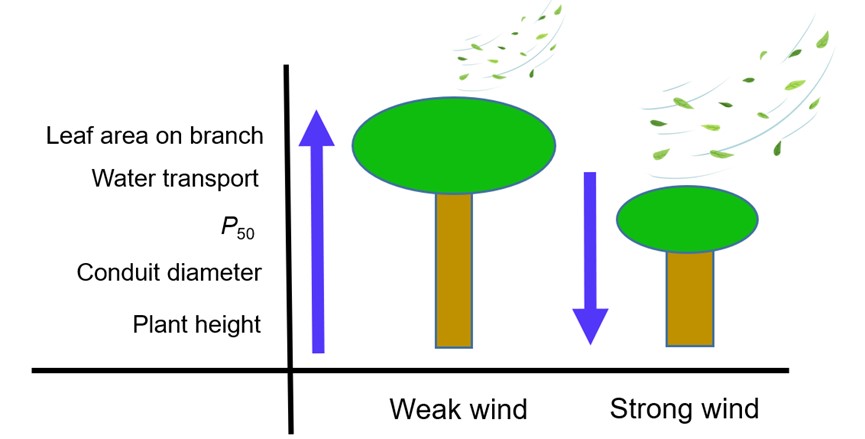Wind speed affects plant hydraulics globally
A research group at South China Botanical Garden (SCBG) of Chinese Academy of Sciences (CAS) published a research article in Nature Ecology & Evolution describes the global variability in plant hydraulics in relation to wind speed.
They found that wind speed clearly affected plant hydraulics even with other climatic factors controlled (for example, moisture index, temperature and vapour pressure deficit). Species from windier sites constructed sapwood with smaller conduit diameter and lower xylem-specific hydraulic conductivity that was more resilient to drought, deploying less leaf total area for a given sapwood cross-section.
Wind has long been regarded as an important ecological factor for forests. It can affect plant hydraulics in a complex way, involving multiple factors related to water and energy balance and their interactions with plant morphology. However, the impact of wind on plant hydraulics at a global scale remains unclear.
Via field measurements, plant traits database, and published literature, they compiled a global dataset of plant hydraulics, including key parameters such as water potential at 50% loss of hydraulic conductivity, xylem-specific hydraulic conductivity, leaf area to sapwood area ratio and conduit diameter for 1,922 woody species sampled from 469 sites worldwide (2,786 species-at-site combinations in total).
“Species with these traits may be at an advantage under future climates with higher wind speeds.
Given the rapid increase in wind speeds observed in recent decades, it is important to recognize that the impacts of wind speed on plants may offset the feedback of other global changes, such as CO2 fertilization, nitrogen deposition, and even global warming.” said Dr. HE Pengcheng, the first author of the paper.
This study provides a global perspective on the critical effects of wind on plant hydraulic traits. The mechanisms underpinning this intriguing finding are not yet well understood but suggest that serious research efforts, including laboratory and field control experiments, should be directed at this issue. It also suggests that there may be potential to develop more robust global vegetation models by incorporating mechanistic links between wind speed and plant hydraulics.
For further reading, please find the paper entitled “Relationship between wind speed and plant hydraulics at the global scale”. The article link is:https://doi.org/10.1038/s41559-024-02603-5

Figure 1. Conceptual framework for water fluxes in plants under different wind scenarios. High wind speeds reduce canopy and vegetation boundary layer resistances, leading to increased atmospheric aridity and mechanical damage for plants. Under this condition, it is advantageous for plants to have high drought tolerance, low leaf area on branches and high mechanical resistance. By contrast, in areas with low wind speeds, plants benefit from high water transport and fast growth because low wind speeds result in less drought stress, defoliation and windthrow.(Image by HE et al)
File Download: